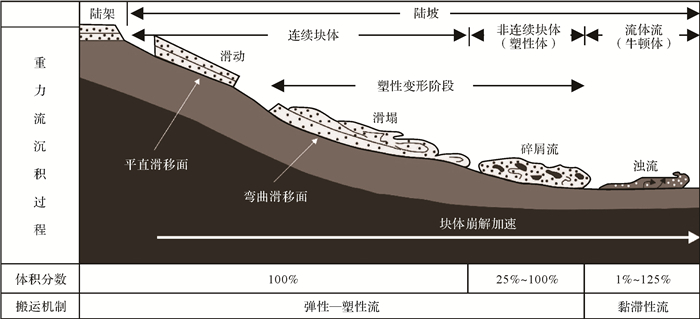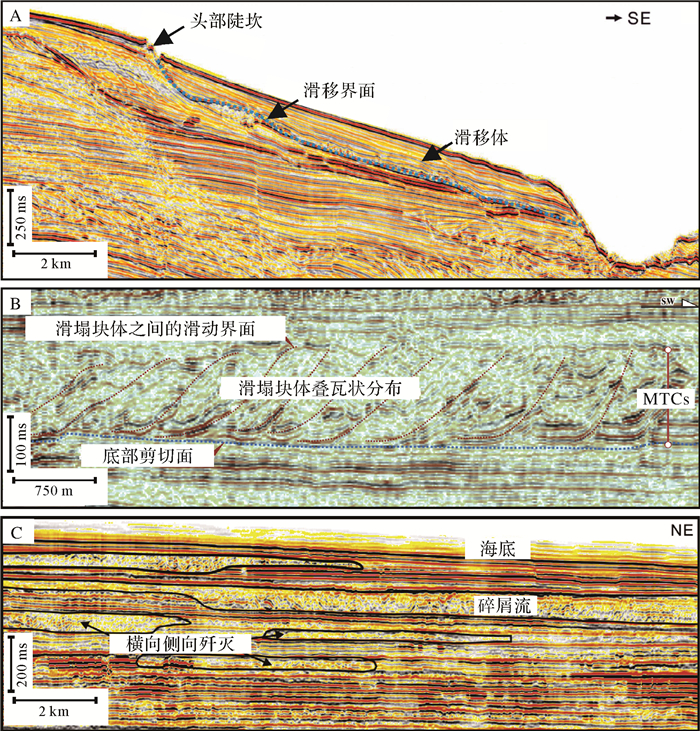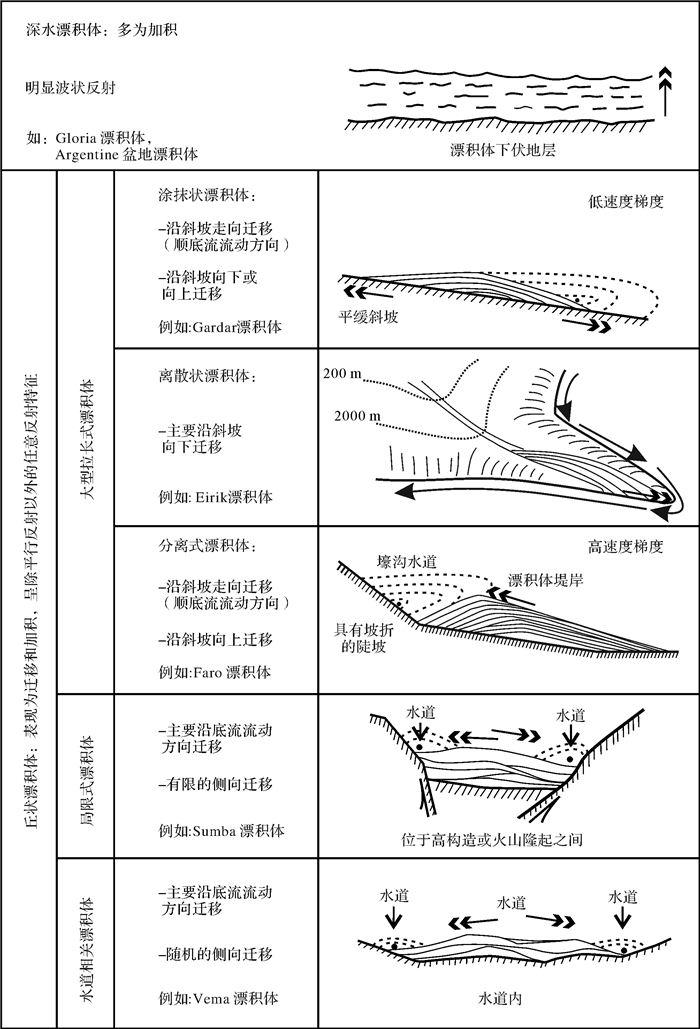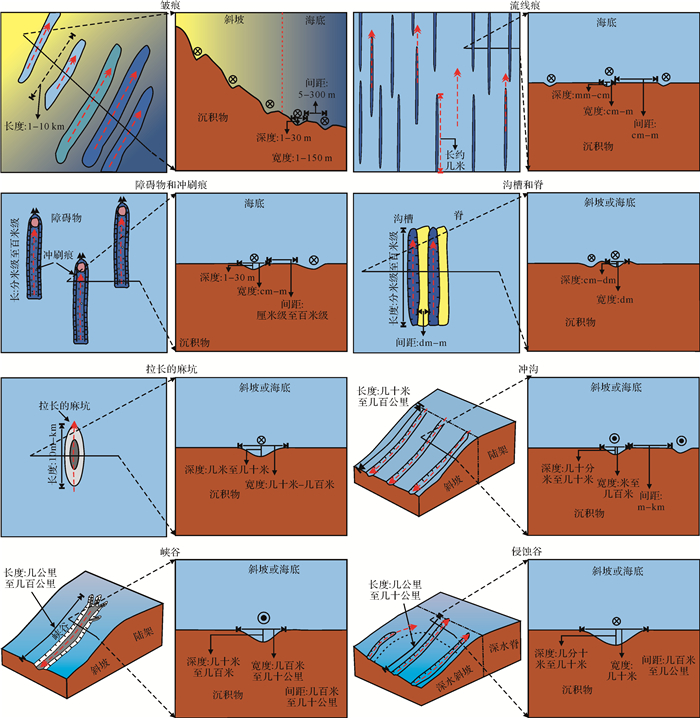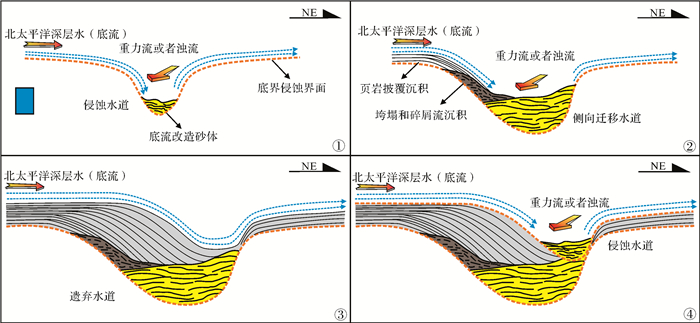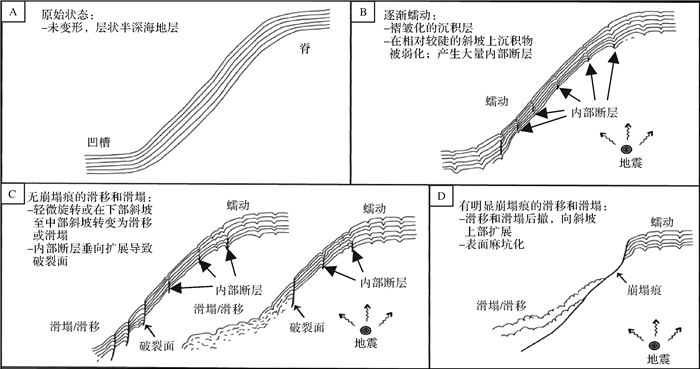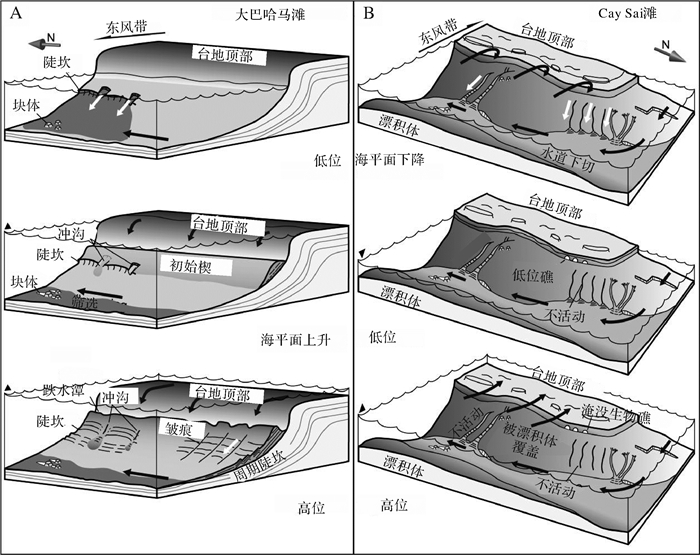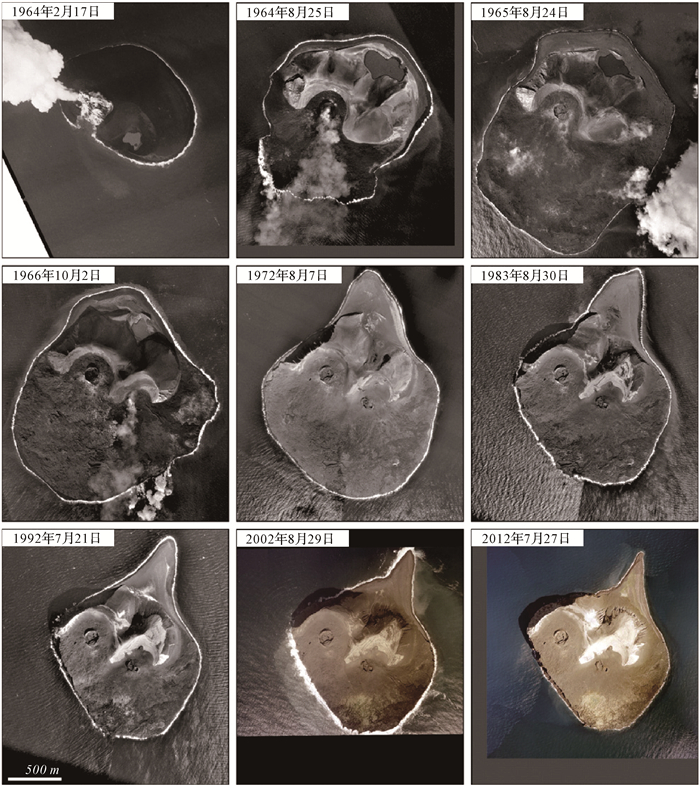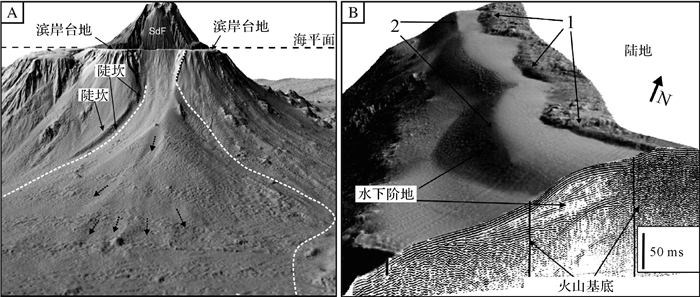扩展功能
文章信息
- 马本俊, 秦志亮, 吴时国, 高微, 高金尉, 王吉亮, 孙金, 陈传绪
- MA BenJun, Qin ZhiLiang, WU ShiGuo, GAO Wei, GAO JinWei, WANG JiLiang, SUN Jin, CHEN ChuanXu
- 深水斜坡类型与沉积过程及其产物研究进展
- An Overview of Deep-water Slope Types and Their Corresponding Sedimentary Processes and Productions
- 沉积学报, 2018, 36(6): 1075-1090
- ACTA SEDIMENTOLOGICA SINCA, 2018, 36(6): 1075-1090
- 10.14027/j.issn.1000-0550.2018.089
-
文章历史
- 收稿日期:2017-09-13
- 收修改稿日期: 2017-12-14
2. 哈尔滨工程大学水声工程学院, 哈尔滨 150001;
3. 中国科学院深海科学与工程研究所深海地球物理与资源研究室, 海南三亚 572000;
4. 青岛国家海洋科学与技术实验室 海洋地质研究室, 山东青岛 266061;
5. 中国科学院大学, 北京 100049;
6. 中国科学院海洋研究所海洋地质与环境重点实验室, 山东青岛 266071
2. College of Underwater Acoustic Engineering, Harbin Engineering University, Harbin, 150001, China;
3. Laboratory of Marine Geophysics and Georesource, Institute of Deep-sea Science and Engineering, CAS, Sanya, Hainan 572000, China;
4. Functional Laboratory for Marine Geology and Environment, Qingdao National Laboratory for Marine Science and Technology, Qingdao, Shandong 266061, China;
5. University of Chinese Academy of Sciences(UCAS), Beijing 100049, China;
6. Key Laboratory of Marine Geology and Environment, Institute of Oceanology, Chinese Academy of Sciences, Qingdao, Shandong 266071, China
深水海底蕴含着丰富的能源矿产资源,包括石油、天然气以及天然气水合物等。随着对海洋探测程度的加深,研究者越来越认为深水区蕴含着更为丰富的矿产资源,因此深水区是“打开海洋资源之门的钥匙”[1]。深水斜坡是连接浅水陆架或孤立浅水台地与深海盆地之间的纽带和桥梁,在浅水沉积物向深海盆地输送过程中发挥着决定性的作用。正确认识深水斜坡沉积规律,将直接决定寻找深水砂体的成功与否,这对深水油气资源勘探开发具有十分重要的意义。此外,深水斜坡发育着广泛的海底滑坡、浊流等重力流过程[2-5],会对海底地层造成强烈破坏,因此,正确认识深水斜坡沉积规律,对海底地质灾害的预测和防护也具有十分重要的意义。
由于深水斜坡沉积过程的复杂性,一直是海洋深水沉积研究难点。深水斜坡发育不同类型的沿斜坡搬运的重力流过程,而且不同类型流相态之间存在过渡转变过程[6-10]。此外,深海底流活动在深水海底广泛存在,其可以对沉积物的形成强烈改造过程[11-12],而且深水斜坡沉积过程往往还存在重力流与底流复杂的交互作用[13-14];这都极大干扰了对斜坡输送过程及其产物的恢复和识别。为了更加系统全面的掌握深水斜坡沉积规律,有必要对近年来的深水斜坡沉积成果进行系统地梳理和总结。
实际上,深水斜坡沉积过程及其复杂的主要原因之一是因为斜坡沉积背景多种多样。在大型河流注入的陆架斜坡,主要发育陆源硅质碎屑沉积;在缺乏陆源输入的浅水陆架或孤立碳酸盐台地及其斜坡,主要发育内源岩沉积为主的碳酸盐岩堆积;火山周缘斜坡在火山喷发时期,主要发育火山碎屑岩堆积为主的裙裾带;而且在不同的沉积背景下,沉积物堆积方式、输送规律及其控制因素都存在显著差异[15-22]。比如在陆源碎屑沉积为主的陆架斜坡,多发育点源式大型峡谷水道,并且主要形成于陆源碎屑沉积物输入较高的低位海平面时期[23-24];而碳酸盐台地周缘斜坡多发育线源式的裙裾带,沉积物输送鼎盛时期往往集中于台地生产力较高的高海平面时期[25-27];海底火山斜坡也发育斜坡裙裾带,但其堆积过程集中在相对短暂的火山喷发时期,通常形成与“正常”盆地背景下截然不同沉积产物[28]。因此,本文以斜坡发育背景为主线深入系统地分析了三种类型深水斜坡沉积作用及其产物,即深水陆架斜坡、孤立碳酸盐台地周缘斜坡(称为“碳酸盐斜坡”)、海底火山周缘深水斜坡(在本文中简称“火山斜坡”)。
1 深水陆架斜坡由于深水陆架斜坡沉积规律研究最为成熟和广泛,导致其成为现代深水沉积学的理论基础和主要内容。沉积学家最初认为深水环境缺乏粗粒沉积物来源,沉积主要以悬浮颗粒的缓慢沉降为主。但随后科学家在深水斜坡,观测到广泛分布的峡谷水道体系,使科学家认识到在深海海底除了缓慢沉降沉积以外,还普遍存在着海底浊流[1, 29]。随着海洋观测技术的进步,深水沉积学家发现海底常年发育底流活动,可对原有的沉积产物进行改造,并发生再输送再沉积过程;比如深水斜坡之上发育的漂积体、等深流水道等,都是底流改造作用下的沉积产物[3, 30-37]。总的来说,根据沉积物输送动力,深水陆架斜坡沉积过程可以被划分为三种类型:重力驱动的重力流沉积过程、底流(等深流)输送沉积过程以及两者交互沉积过程(图 1)。
重力流是指以重力为主要搬运动力形成的一种沉积物流,其在输送过程中会对海底造成强烈侵蚀作用[38-39]。重力流可将沉积物快速搬离原地并输送到几百公里甚至上千公里以外的深海盆地,可见其强大的输送能力。根据重力流搬运过程中的相态变化,重力流沉积物产物可以划分为块体搬运体系(Mass transport complexes,简称MTCs)和浊流沉积体系。MTCs是一种弹性—塑性流态下的产物,沿斜坡向下分别出现滑动、滑塌、碎屑流等沉积类型[3-4, 40](图 2)。滑动(Slide)是一种弹性流体,沉积物作为一个整体,在重力驱动下沿着较为平直的剪切面滑动,沉积物内部基本上不发生变形[41]。滑塌(Slump)是一种弹性向塑性流态转变的相态,沿上凹剪切面旋转滑动,沉积物内部一般保持连贯,但夹杂着由于旋转而产生的沉积物变形[40-41]。碎屑流(Debris flow)发生在滑塌之后,已完全转变为塑性流态,沉积物呈线性层状流动,内部表现为颗粒支撑,杂乱堆积[41];浊流是一种黏滞性流,具有牛顿流体性质,沉积物内部颗粒主要表现为湍流方式支撑,最后沉积以悬浮沉降为主,形成正粒序层序特征,也就是“鲍马序列”[42]。滑动、滑塌、碎屑流以及浊流也可以是同一沉积块体在不同阶段的表现形式,也就是说不同流态的重力流类型,沿斜坡向下,具有滑动—滑塌—碎屑流—浊流的转变过程[29]。
1.1.1 块体搬运体系(MTCs)MTCs是沉积物从陆架坡折带向深海盆地输送的一种快速有效的事件性搬运过程,在深海斜坡之上具有广泛的发育范围,通常只发生在浅表层[43-44]。研究人员认为,当沉积物受到的外界应力超过了岩石的抗破裂强度时,首先发生表层沉积物脱离,然后脱离块体在重力的驱动下,沿斜坡搬运,形成滑动或滑塌,随后转变为碎屑流[45-46]。理论上,只要能导致岩石抗破裂强度减弱以及沉积物所受外界应力增大的因素都可以触发MTCs。断层活动、基底沉降等构造活动因素,可能会导致海底斜坡陡化,原有沉积物自身重力沿斜坡的分量增大,会对海底斜坡剪切作用增强,从而触发大型块体流事件。构造因素触发的MTCs,一般需要经历缓慢的应力积累,具有发生频率低,间歇时间长,但发生规模大的特点[47-49]。地震、火山喷发及其引发的海啸、风暴浪、潮汐流等大规模海水运动,也会触发不稳定的斜坡沉积物,形成MTCs事件。最新研究显示,斜坡沉积物中的水合物分解,会迅速增大沉积物空隙压力,降低沉积物抗剪切强度,从而引发海底MTCs[50-51]。实际上,MTCs更多的是在多因素的联合作用下形成的。
Bull et al.[41]将MTCs的空间结构依次划分为三个单元,分别为靠近最开始发生部位的头部拉张区、中间部位的体部滑移—挤压变形区,以及趾部挤压变形区(图 3)。
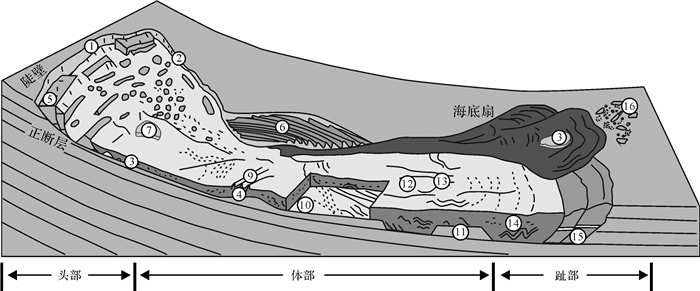
|
| 图 3 MTCs的内部结构模式图解[41] 1.头壁;2.侧壁(陡坎);3.滑移剪切面;4.局部隆起;5.拉张脊与块体;6.侧向挤压脊;7.残留块体;8.漂块;9.挤压脊;10.底界剪切面沟槽;11.底界斜坡与平地;12.火山等正地形;13.二次流建造;14.褶皱;15.褶皱与逆冲体系;16.逸出块体浊流体系 Figure 3 Schematic of the internal architecture for MTCs[41] 1. headwall; 2. lateral margin (Scarp); 3. slide surface; 4. local uplifts; 5. extensional ridge and blocks; 6. lateral compression ridge; 7. remnant block; 8. erratic block; 9. pressure ridge; 10. basal shear surface groove; 11. basal shear ramps and flats; 12. positive geomorphology like volcano; 13. second order flow fabric; 14. fold; 15. fold and thrust systems; 16. outrunner blocks |
(1) 头部拉张区:斜坡沉积物由于自身重力或其他触发机制,受到沿斜坡方向的拉张应力,而发生破裂崩塌。崩塌区域由于沉积物被搬离,造成地层缺失,表现为断崖或陡坎;滑塌体沿斜坡搬运过程中,内部还保留部分拉张应力,导致形成犁式正断层;滑移体或滑塌体沿斜坡向下滑动,侵蚀海底或围岩,进一步造成海底地层缺失,形成侧壁陡坎。拉张断层和断崖是头部拉张区最为明显的识别标志之一。
(2) 体部滑移—挤压变形区:沿斜坡向下,地形坡度逐渐变小,重力驱动变弱,少量沉积物开始发生沉积,主要为部分大型滑动块体由于缺乏动力,堆积海底,形成漂块;继续滑动的块体对海底仍然具有很强的侵蚀性,表现为发育广泛的侵蚀沟槽和坡坪;当滑移体或滑塌体遇到火山等海底正地形阻挡时,会绕开正地形,或在其之前堆积,从而使得正地形后面海底沉积物免遭破坏,正地形之后的原状地层称为残留地层。
(3) 趾部挤压变形区:该区域地形更加平缓,沉积物输送动力进一步变弱,是沉积发生的主要部位。在搬运过程中,沉积物逐渐变形破碎化,逐渐转变为碎屑流。碎屑流内部颗粒运动速度逐渐出现差异,沉积物搬运方向前部运动较慢的沉积物颗粒与后部移动较快的颗粒相互挤压,导致在与搬运方向垂直的的方向上形成挤压脊、以及逆冲断层。还有部分块体,具有较大动能,从MTCs的主体中逃逸出来,被输送到更远的深水区域,该部分块体就称为逸出块体。
MTCs内部结构具有明显的识别特征,因此可以利用高分辨率地震资料识别大型MTCs,并可圈定其三维空间上的分布范围[47-51]。滑动块体底界面(剪切侵蚀界面)主要表现为强振幅、高连续反射,内部同相轴保留原有地层的反射特征;滑塌体同样具有强振幅、高连续反射的顶底界面,但内部同相轴一般发育沉积物变形的反射特征;碎屑流沉积体与上覆地层往往呈不规则接触,侧向尖灭,内部同相轴多表现为弱振幅且杂乱的反射特征(图 4、表 1)。
| MTCs类型 | 地震反射特征 |
| 滑动(Slide) | 强振幅、高连续顶底界面,内部保留原有地层发射特征 |
| 滑塌(Slump) | 强振幅、高连续顶底界面,内部强烈变形反射,可见挤压脊,叠瓦状滑动,双重构造 |
| 碎屑流(Debris flow) | 剪切侵蚀界面不规则,多表现为侧向歼灭,内部变形明显,表现为杂乱反射 |
20世纪30年代,学者意识到海底斜坡存在广泛的浊流过程,侵蚀海底形成峡谷水道等线性沉积地貌[52]。实际上,浊流是一种与块体流不同的重力流过程,在重力驱动下,沉积物主要以悬浮湍动的形式沿斜坡输送。浊流头部在流动过程中,对海底具有很强的侵蚀性,可以不断侵蚀海底沉积物再悬浮,从而不断被浊流捕获[42, 53]。有研究表明,在浊流内部粗粒沉积物从下到上呈递减趋势变化,而细粒沉积物在垂向上却几乎没有变化,当浊流沉积后,就会形成“鲍马序列”[54]。流动中的浊流,底部粗颗粒沉积物会受到海底摩擦力阻碍,导致流动速度变慢;顶部细颗粒沉积物受到海水的黏滞力的阻碍,速度也会变慢;中部颗粒受到阻力最小,流动最快;浊流内部垂向上的速度差异,造成上层颗粒相对中层沉积物颗粒向后旋转,形成波状的沉积底形,称为浊流沉积物波(图 5)。浊流最为显著的特征就是对海底的强烈侵蚀,塑造了海底峡谷、水道等沉积体系[56-58]。
影响深水斜坡沉积的牵引流,主要包括底流(等深流)、内孤立波以及中尺度涡等,是具有牛顿流体性质的流体,对深水斜坡沉积物具有强烈的改造作用[59-60]。深水牵引流对沉积物的改造主要表现为两个方面,包括对沉积物输送和对海底的侵蚀。本文将重点讨论包括等深流在内的底流沉积效应及其产物。
等深流(Contour current)是因地球旋转而形成的沿等深线流动的大型温盐环流[61]。在研究初期,若不强调“等深”这一特征,也可将等深流笼统的称为底流(Bottom current),这是狭义的底流涵义。当前,底流不再仅仅指等深流,其含义被扩展为包括等深流在内的一切接近海底的流动[61]。长期稳定的底流可以携带大量的沉积物,并在流动强度减弱的区域快速堆积,其沉积产物形态、内部结构可以将底流流向、强度以及演化过程等重要信息记录下来[62]。在以往报道中,研究人员将底流改造形成的堆积产物统称为漂积体(Drift);并基于漂积体形态及其内部结构,将其划分为深水漂积体以及丘状漂积体两大类,其中深水漂积体主要为板状漂积体,丘状漂积体具有迁移加积特征,据形态变化,又可细分为涂抹状、分离状、隔断式、封闭式以及水道相关的漂积体等(图 6)[61]。
底流强度较大时,会对海底造成侵蚀,造成沉积间断,并形成侵蚀地貌[63-64]。Sun et al.[65]系统地总结了底流侵蚀海底斜坡,形成的线型侵蚀地貌,包括等深流侵蚀形成的皱痕、底流遇障碍物形成的冲刷痕、拉长的麻坑、流线痕、侵蚀谷等(图 7)。像浊流侵蚀形成的峡谷、冲沟,与重力驱动下的沉积物输送有关,延伸方向与斜坡倾向一致;但底流侵蚀形成的线型地貌,延伸方向主要受控于底流流动方向,与地形几乎无关[65]。若底流方向与斜坡倾向相同或相反,侵蚀海底,同样会形成沿斜坡倾向的线型地貌,与浊流成因的线型地貌类似,容易混淆。
实际上,同一地点深水环境往往不会单纯的受控于底流或重力流,更为可能的是同时存在重力流与底流活动,或不同时期重力流与底流交互成为主导作用。这种重力流与底流共同或不同时期交替主导该区域的沉积过程,称为重力流与底流交互作用。重力流沿斜坡将沉积物输送至深水盆地,沉积后受到底流改造,发生再输送、再沉积;此外,在底流作用较强的斜坡区域,底流侵蚀海底会增加海底不稳定性,从而诱发产生滑塌等重力流过程[13]。近几年,重力流与底流交互作用的报道越来越多,其中Gong et al.[14], Gong et al.[66]和Zhu et al.[67]对海底单向迁移水道形成和演化模式的研究,是重力流和底流交互作用的典型实例。单向迁移水道的形成和演化过程可以总结为如下过程:
(1) 在低海平面时期,陆源物质可以输送到更远的陆架坡折,沿斜坡向下的浊流较为发育,表现为发生强度大、频率高。浊流主导下的斜坡,受到强烈侵蚀,形成侵蚀沉积地貌—峡谷水道。这段时期,斜坡沉积物主要表现为“过路”作用,水道内只有少量滞留沉积;此时,底流作用微弱,对沉积物几乎没有改造作用(图 8-①)。
(2) 在海平面开始上升时期,沿斜坡向下的沉积物供给变少,浊流开始变弱,导致水道侵蚀变弱,水道内逐渐被沉积物所充填;此时平行斜坡流动的底流活动开始变强,局部可能触发水道侧壁滑塌体的出现(图 8-②)。
(3) 高海平面时期,底流强度达到鼎盛,替代浊流,成为主导斜坡沉积过程的主要因素。底流流动方向与水道延伸方向垂直,可将细粒沉积物搬离原地,从而在水道侧壁形成向底流流动方向进积的侧向进积体,造成对水道的侧向充填;只有底流流动方向一侧水道残留继续存在(图 8-③)。
(4) 当海平面下降再次进入低海平面时期,浊流活动逐渐变强,替代底流,再次成为斜坡沉积过程的主导因素;浊流在残留水道中继续发育,形成新的水道体系;在海平面的控制下,以上过程交替出现,最终形成了单向迁移水道(图 8-④)。
1.4 斜坡沉积物蠕动(Sediment creep)在重力的驱动下,深水陆架斜坡上的沉积物,除了发生快速搬运的重力流过程,还存在一种十分缓慢的滑动过程,即沉积物蠕动[68]。蠕动地层通常由高塑性的细粒沉积物组成,发育在较为平缓的斜坡之上。蠕动早期,地层内部没有明显破碎现象,一般作为一个整体沿层理面、断层面或节理面发生缓慢的移动;并主要受控于斜坡的坡度、岩性、沉积物孔隙压力等因素[69]。长时间的蠕动变形积累,会导致地层内部破裂,进而导致蠕动块体向滑塌过程转变[70]。这说明沉积物蠕动预示着斜坡具有潜在的滑塌风险[71]。沉积物蠕动转化为滑塌和沉积物蠕动变形有关,主要成因机制可以概括为:蠕动界面对蠕动块体造成剪切,导致沉积物内部变形,主要有两种表现形式:一是沉积物挠曲,形成小型褶皱;二是地层破裂,形成内部断层[69-71];当蠕动变形累积到一定程度,大量地层破裂会迅速发生,岩石抗破裂强度迅速降低;在重力作用下或其他触发因素(地震、火山喷发等)作用下,蠕动块体就会出现崩塌(图 9)。目前,对斜坡沉积物蠕动及其变形的研究程度还很低,主要原因在于蠕动过程极其缓慢,变形程度较小,利用现有技术识别蠕动变形难度较大。借助高分辨率的地震底料以及海底多波束测深资料,是今后识别海底蠕动或蠕动变形的有效手段;并且借助实验室物理模拟,是对海底蠕变研究必不可少的研究内容。
碳酸盐台地是指浅水环境下由于碳酸盐岩堆积所形成的水下高台,比如生物礁组成的大型环礁等。孤立碳酸盐台地(简称“孤立台地”)通常出现在深水环境背景之下,远离陆地,几乎不受陆源碎屑物质输入影响;孤立台地的典型研究实例包括巴哈马群岛、马尔代夫群岛、西沙群岛等岛礁型碳酸盐台地[72-74]。在孤立台地周缘就发育着碳酸盐斜坡,,其主要接受台地脱落的碳酸盐岩碎屑输入,形成异地碳酸盐岩堆积[44]。
基于碳酸盐斜坡地形地貌特征,将其划分为两种类型:一是平缓型斜坡(carbonate ramp),主要表现为水深逐渐加深,向深海盆地平缓过渡[75-76];二是镶边型斜坡,表现为水深迅速加深,向深海盆地快速过渡[77-80]。碳酸盐台地生产力及其输出能力决定了台地与碳酸盐斜坡沉积速率的差异,进而决定了碳酸盐斜坡类型。如果台地垂向生长缓慢或向碳酸盐斜坡输出沉积物数量大、频率高,那么台地与碳酸盐斜坡沉积速率差异小,则台地周缘发育较为平缓的斜坡类型;如果台地垂向生长快或向边缘斜坡输出沉积物数量小、频率低,则台地周缘发育较为陡峻的斜坡类型[81]。其中,台地发育大型环礁时,垂向生长较快,相应的发育陡峻斜坡,故而环礁往往与陡峻的碳酸盐斜坡伴生;这种发育环礁和陡峻斜坡的台地称为镶边型台地,对应的碳酸盐斜坡称为镶边型斜坡。此外,碳酸盐斜坡沉积过程及其产物对台地生长状态异常敏感,因此,可以通过研究不同时期的碳酸盐斜坡沉积特征,来揭示碳酸盐台地当时的生长状态,进而判断台地对应时期是否处于健康的生长阶段[19]。
碳酸盐斜坡不同于陆架斜坡,沉积过程至少有4点存在差异:1)碳酸盐斜坡沉积物来自于碳酸盐台地,是造礁生物从海水捕获或凝结的碳酸盐矿物,本质上是内源岩;陆架斜坡沉积物主要来自于陆地风化剥蚀产物,本质上是河流输入的硅质碎屑沉积物[18, 82]。2)碳酸盐斜坡对沉积物的输送模式多表现为线源式,形成环绕台地的裙裾带沉积[44];而陆架斜坡对沉积物输送模式往往表现为点源式,形成大型峡谷—水道—海底扇沉积[16, 21-23]。3)碳酸盐斜坡主要在海平面高位期输送碳酸盐岩碎屑沉积物,而陆架斜坡主要在海平面低位期输送陆源碎屑[27, 83-84]。4)碳酸盐斜坡是以间歇的方式输出沉积物,台缘水深较浅,可受控于波浪、潮汐、风暴浪及其引发的密度流[85];而陆架斜破虽然也表现为间歇的方式输出沉积物,但主要以为重力流输送为主,水深较深,受波浪、潮汐影响较小。
孤立碳酸盐台地远离陆地,几乎不受陆源碎屑注入影响,碳酸盐斜坡主要接受台地脱落碎屑输入,形成异地碳酸盐岩堆积;或与半深海软泥混合,形成混合沉积[80, 86-88]。异地碳酸盐岩,也有人称其为再沉积碳酸盐岩,广泛发育在碳酸盐斜坡:台地碳酸盐岩在未固结或半固结时由于外力作用,从台地脱落,并被输送到异地堆积[44]。混合沉积也是碳酸盐斜坡较为常见的沉积类型,是指内源碳酸盐岩与陆源硅质碎屑混合后沉积或两者在同一地区不同时期交替沉积形成的交互沉积旋回[89]。最新研究显示,碳酸盐斜坡也存在复杂的沿斜坡重力流输送与横跨斜坡底流作用及其交互作用,并受控于海平面波动、季风演变等因素[73, 90]。在台地生产力较高的高海平面时期,台地输出沉积物能力增强,斜坡堆积的沉积物稳定性差,容易受到外力作用发生斜坡垮塌,形成碳酸盐岩重力流;碳酸盐岩重力流沿斜坡流动过程中,侵蚀海底,形成类似于陆架斜坡的侵蚀沉积地貌,比如MTCs、冲沟、陡坎等;底流活动也可能会直接侵蚀海底,在碳酸盐斜坡形成环绕台地的等深流水道;这种底流侵蚀会进一步增加斜坡坡度,降低斜坡稳定性,促进重力流的形成;底流还可以对斜坡原有的沉积体改造,形成碳酸盐斜坡漂积体(图 10)[73]。
Mulder et al.[78]报道了在现代碳酸盐斜坡背景下,首次发现了类似于碳酸盐岩水道,形态以及内部充填结构与陆架斜坡水道体系相似;但碳酸盐岩水道规模相对较小,与陆架斜坡水道规模相差一个数量级。基于地震资料以及钻孔数据,研究人员在碳酸盐斜坡水道内识别出底部滞留沉积、堤岸以及漫溢等沉积相类型;与陆架斜坡水道类似,碳酸盐斜坡水道通过漫溢可以对沉积物颗粒进行分选,将细粒沉积物漫溢出水道,在水道内形成粗粒沉积物聚积(图 11)。Ma et al.[91]在南海北部流花碳酸盐台地边缘斜坡识别出一条混合沉积水道,揭示了碳酸盐斜坡可以通过原有的陆架斜坡水道输送碳酸盐岩碎屑,形成高频交互混合沉积旋回。以上最新研究表明碳酸盐斜坡沉积过程比之前认为的更为复杂,尤其是台缘水道体系对浅水碳酸盐岩的“源—汇”输送过程扮演着极其重要的作用,这对深水碳酸盐岩堆积和全球碳循环都具有重要意义[78, 92]。相比陆架斜坡,碳酸盐斜坡更容易被胶结,更容易耗散重力流对海底的侵蚀,阻碍沉积物的长距离搬运;而且碳酸盐斜坡缺乏点源式物源输出模式,重力流很难集中在固定的输出路径;以上原因导致碳酸盐斜坡很难形成单条大型碳酸盐岩水道[77-79]。
火山喷发时产生大量的火山物质,并在火山间歇期为周缘斜坡提供沉积物质来源,从而火山活动改变了原有的源汇体系,会“干扰”盆地的正常充填过程[93]。火山喷发聚积的火山物质可形成海底高地或火山岛礁,但新生成的火山还处于极其不稳状态,表现为火山斜坡发生火山碎屑坡移输送(Mass-wasting transport),包括火山物质为主的碎屑流、浊流等;由于火山物质再输送而沉积在火山斜坡之上,形成斜坡裙裾带[94-95]。火山斜坡裙裾带覆盖的范围非常广阔,甚至占整个火山隆起体积的90%[96]。
火山斜坡沉积过程受控于火山活动:1)火山喷发时期,大量的火山物质(包括熔岩和火山灰)堆积,并输送至火山斜坡,形成火山锥[97-98]。2)火山喷发间歇时期,火山及其斜坡上大量的火山物质可以通过重力驱动以及波浪、潮汐以及洋流搬运,将火山碎屑输送至周缘深水盆地,该过程实际上是火山活动创造的新“源—汇”体系[99]。3)火山物质积聚形成的地形起伏会改变原有的水动力条件,从而对火山斜坡沉积体系形成改造[100]。4)火山活动区域基底活动强烈,比如喷发时期,热流值高,基底抬升,但火山间歇时期,岩浆冷却,基底热沉降较快;该过程改变了沉积盆地的可容纳空间,可对盆地充填序列造成影响。
近年来,对火山斜坡沉积过程的研究主要集中在冰岛地区的Surtsey火山以及意大利的斯特隆博利岛区域的Stromboli火山。Surtsey火山在1963—1967年间集中喷发,几年的时间,垂向积聚了几百米厚的火山物质,形成了以火山灰为主的火山岛;喷发停止后,火山岛在海浪的作用下发生快速侵蚀,并将大量的火山碎屑输出到周缘斜坡和深水盆地;几年后,由于强烈的海浪侵蚀,Surtsey火山快速淹没于海平面之下;此外,火山基底热沉降,也促进了火山岛的淹没[93, 99]。图 12为Surtsey火山在不同时期的航拍照片,显示出火山喷发在短时间内,迅速形成火山岛,并在之后,遭受波浪侵蚀快速淹没的过程。Surtsey火山研究实例揭示了火山活动对源汇过程、可容纳空间以及水动力条件的重要影响。
Stromboli火山研究实例显示在火山斜坡发育两种类型斜坡沉积过程。1)不稳定型斜坡沉积过程:在重力作用下,火山碎屑沿斜坡发生快速搬运,形成海底滑坡、侵蚀沟槽等地貌类型。2)稳定型斜坡沉积过程:在波浪、潮汐等水动力作用下,火山碎屑向周缘斜坡快速进积,在剖面上形成类似沙滩一样的进积楔,在三维空间上形成水下平台(图 13)。在远端火山斜坡,逐渐过渡为深水盆地,发育半深海沉积物与火山碎屑的混合沉积[28, 101-104]。最新研究表明,火山周缘火山物质快速输出,可堆积形成类似碳酸盐斜坡的形貌特征[105]。以上观测结果说明了火山斜坡发育多种沉积类型,沉积过程较为复杂。
开展对南海深水斜坡沉积体系的研究,不仅具有重要的科学意义,而且具有实际的现实应用价值。南海发育大陆架、孤立碳酸盐台以及海底火山,具有丰富的斜坡类型,是开展深水斜坡沉积过程研究的天然实验室。而且实际勘探工作表明,南海深水区蕴藏着丰富的油气以及天然气水合物等矿产资源,但目前对其研究程度还很低。此外,近年来,南海岛礁开发等工程建设也正在如火如荼的开展,急需加强对深水斜坡潜在的地质灾害进行监控。因此,本文综述近年来不同的深水斜坡沉积理论,对我们开展南海深水斜坡沉积研究具有如下启示:
首先,要认识到不同斜坡类型涉及的沉积过程存在较大差异,因此,不能简单的混用或套用单一背景下斜坡沉积理论。南海具有多背景下不同类型的深水斜坡,有必要对不同背景下的深水斜坡体系进行系统的分类研究;建立标准对不同的深水斜坡进行系统分类,从而将不同特点的深水斜坡沉积体系纳入到一个统一的理论框架之下。
其次,南海深水环流模式复杂,而且强度较大,对深水斜坡沉积体系具有较强的改造作用。尤其是与深水斜坡等深线近于平行的方向,等深流活动对斜坡形态的形成具有重要影响。因此,在研究深水沉积体系时,除了关注沉积物的跨斜坡输送过程,还应特别关注平行斜坡的等深流沉积效应。实际上,深水沉积过程更多的表现为重力流与底流活动的交互作用,综合考虑两者之间的相互作用关系,才能更为真实的还原深水沉积过程。
| [1] |
《全球变化及其区域响应》科学指导与评估专家组. 深入探索全球变化机制:国家自然科学基金委重大研究计划的战略研究[J]. 中国科学(D辑):地球科学, 2012, 42(6): 795-804. [ Scientific Steering Group of the Major Project "Global Change and Regional Response". Exploring the mechanism of global change-Research strategy of major projects of the National Natural Science Foundation of China[J]. Science China (Seri.D):Earth Sciences, 2012, 42(6): 795-804.] |
| [2] |
Dott Jr R H. Dynamics of subaqueous gravity depositional processes[J]. AAPG Bulletin, 1963, 47(1): 104-128. |
| [3] |
Shanmugam G, Spalding T D, Rofheart D H. Process sedimentology and reservoir quality of deep-marine bottom-current reworked sands (sandy contourites):An example from the Gulf of Mexico[J]. AAPG Bulletin, 1993, 77(7): 1241-1259. |
| [4] |
Shanmugam G. High-density turbidity currents; are they sandy debris flows?[J]. Journal of Sedimentary Research, 1996, 66(1): 2-10. DOI:10.1306/D426828E-2B26-11D7-8648000102C1865D |
| [5] |
徐景平. 海底浊流研究百年回顾[J]. 中国海洋大学学报(自然科学版), 2014, 44(10): 98-105. [ Xu Jingping. Turbidity urrent research in the past century:An overview[J]. Periodical of Ocean University of China, 2014, 44(10): 98-105.] |
| [6] |
Jakobsson S P, Gudmundsson G, Moore J G. Geological monitoring of Surtsey, Iceland, 1967-1998[J]. Surtsey Research, 2000, 11: 99-108. |
| [7] |
Yuan S Q, Wu S G, Thomas L, et al. Fine-grained pleistocene deepwater turbidite channel system on the slope of Qiongdongnan Basin, northern South China Sea[J]. Marine and Petroleum Geology, 2009, 26(8): 1441-1451. DOI:10.1016/j.marpetgeo.2009.03.007 |
| [8] |
McLaughlin C J, Smith C A, Buddemeier R W, et al. Rivers, runoff, and reefs[J]. Global and Planetary Change, 2003, 39(1/2): 191-199. |
| [9] |
Shanmugam G. 深水砂体成因研究新进展[J]. 石油勘探与开发, 2013, 40(3): 294-301. [ Shanmugam G. New perspectives on deep-water sandstones:Implications[J]. Petroleum Exploration and Development, 2013, 40(3): 294-301.] |
| [10] |
吴时国, 秦志亮, 王大伟, 等. 南海北部陆坡块体搬运沉积体系的地震响应与成因机制[J]. 地球物理学报, 2011, 54(12): 3184-3195. [ Wu Shiguo, Qin Zhiliang, Wang Dawei, et al. Seismic characteristics and triggering mechanism analysisi of mass transport deposits in the nothern continental slope of the South China Sea[J]. Chinese Journal of Geophysics, 2011, 54(12): 3184-3195. DOI:10.3969/j.issn.0001-5733.2011.12.018] |
| [11] |
Gong C L, Wang Y M, Peng X C, et al. Sediment waves on the South China Sea Slope off southwestern Taiwan:Implications for the intrusion of the northern Pacific deep water into the South China Sea[J]. Marine and Petroleum Geology, 2012, 32(1): 95-109. DOI:10.1016/j.marpetgeo.2011.12.005 |
| [12] |
宋海斌. 南海深海物理过程与地质过程的关系探讨[J]. 热带海洋学报, 2012, 31(3): 10-20. [ Song Haibin. On relationship between physical process and geological process in South China Sea deep[J]. Journal of Tropical Oceanography, 2012, 31(3): 10-20.] |
| [13] |
吴嘉鹏, 王英民, 王海荣, 等. 深水重力流与底流交互作用研究进展[J]. 地质论评, 2012, 58(6): 1110-1120. [ Wu Jiapeng, Wang Yingmin, Wang Hairong, et al. The interaction between deep-water turbidity and bottom currents:A review[J]. Geological Review, 2012, 58(6): 1110-1120. DOI:10.3969/j.issn.0371-5736.2012.06.011] |
| [14] |
Gong C L, Wang Y M, Steel R J, et al. Flow processes and sedimentation in unidirectionally migrating deep-water channels:From a three-dimensional seismic perspective[J]. Sedimentology, 2016, 63(3): 645-661. DOI:10.1111/sed.2016.63.issue-3 |
| [15] |
Normark W R, Piper D J W. Deep-sea fan-valleys, past and present[J]. Geological Society of America Bulletin, 1969, 80(9): 1859-1866. DOI:10.1130/0016-7606(1969)80[1859:DFPAP]2.0.CO;2 |
| [16] |
Normark W R. Fan valleys, channels, and depositional lobes on modern submarine fans:characters for recognition of sandy turbidite environments[J]. AAPG Bulletin, 1978, 62(6): 912-931. |
| [17] |
Droxler A W, Schlager W. Glacial versus interglacial sedimentation rates and turbidite frequency in the Bahamas[J]. Geology, 1985, 13(11): 799-802. DOI:10.1130/0091-7613(1985)13<799:GVISRA>2.0.CO;2 |
| [18] |
Watkins R T. Volcano-tectonic control on sedimentation in the Koobi Fora sedimentary basin, Lake Turkana[J]. Geological Society, London, Special Publications, 1986, 25(1): 85-95. DOI:10.1144/GSL.SP.1986.025.01.08 |
| [19] |
Glaser K S, Droxler A W. High production and highstand shedding from deeply submerged carbonate banks, northern Nicaragua Rise[J]. Journal of Sedimentary Research, 1991, 61(1): 128-142. |
| [20] |
Wilson P A, Roberts H H. Carbonate-periplatform sedimentation by density flows:A mechanism for rapid off-bank and vertical transport of shallow-water fines[J]. Geology, 1992, 20(8): 713-716. DOI:10.1130/0091-7613(1992)020<0713:CPSBDF>2.3.CO;2 |
| [21] |
Clark J D, Pickering K T. Submarine channels:processes and architecture[M]. London: Vallies Press, 1996: 13-172.
|
| [22] |
Hiscott R N, Hall F R, Pirmez C. Turbidity-current overspill from the Amazon Channel: Texture of the silt/sand load, paleoflow from anisotropy of magnetic susceptibility, and implications for flow processes[M]//Flood R D, Piper D J W, Klaus A, et al. Proceedings of the ocean drilling program, scientific results. College Station, Texas: National Science Foundation, 1997: 53-78.
|
| [23] |
Jobe Z R, Sylvester Z, Parker A O, et al. Rapid Adjustment of Submarine Channel Architecture To Changes In Sediment Supply[J]. Journal of Sedimentary Research, 2015, 85(6): 729-753. DOI:10.2110/jsr.2015.30 |
| [24] |
Ding W W, Li J B, Li J, et al. Morphotectonics and evolutionary controls on the Pearl River Canyon system, South China Sea[J]. Marine Geophysical Research, 2013, 34(3/4): 221-238. |
| [25] |
Wilson J L. Cyclic and reciprocal sedimentation in Virgilian strata of southern New Mexico[J]. Geological Society of America Bulletin, 1967, 78(7): 805-818. DOI:10.1130/0016-7606(1967)78[805:CARSIV]2.0.CO;2 |
| [26] |
Betzler C, Hübscher C, Lindhorst S, et al. Lowstand wedges in carbonate platform slopes (Quaternary, Maldives, Indian Ocean)[J]. Depositional Record, 2016, 2(2): 1-12. |
| [27] |
Lantzsch H, Roth S, Reijmer J J G, et al. Sea-level related resedimentation processes on the northern slope of Little Bahama Bank (Middle Pleistocene to Holocene)[J]. Sedimentology, 2007, 54(6): 1307-1322. DOI:10.1111/sed.2007.54.issue-6 |
| [28] |
Casalbore D, Romagnoli C, Chiocci F, et al. Morpho-sedimentary characteristics of the volcaniclastic apron around Stromboli volcano (Italy)[J]. Marine Geology, 2010, 269(3/4): 132-148. |
| [29] |
Shanmugam G. 50 years of the turbidite paradigm (1950s-1990s):Deep-water processes and facies models-a critical perspective[J]. Marine and Petroleum Geology, 2000, 17(2): 285-342. DOI:10.1016/S0264-8172(99)00011-2 |
| [30] |
Faugères J C, Stow D A V, Imbert P, et al. Seismic features diagnostic of contourite drifts[J]. Marine Geology, 1999, 162(1): 1-38. DOI:10.1016/S0025-3227(99)00068-7 |
| [31] |
Lüdmann T, Wong H K, Berglar K. Upward flow of North Pacific Deep Water in the northern South China Sea as deduced from the occurrence of drift sediments[J]. Geophysical Research Letters, 2005, 32(5): L05614. |
| [32] |
Chen G X, Hou Y J, Chu X Q. Mesoscale eddies in the South China Sea:Mean properties, spatiotemporal variability, and impact on thermohaline structure[J]. Journal of Geophysical Research, 2011, 116(C6): C06018. |
| [33] |
Rebesco M, Hernández-Molina F J, van Rooij D, et al. Contourites and associated sediments controlled by deep-water circulation processes:State-of-the-art and future considerations[J]. Marine Geology, 2014, 352: 111-154. DOI:10.1016/j.margeo.2014.03.011 |
| [34] |
陈慧, 解习农, 毛凯楠. 南海北缘一统暗沙附近深水等深流沉积体系特征[J]. 地球科学——中国地质大学学报, 2015, 40(4): 733-743. [ Chen Hui, Xie Xinong, Mao Kainan. Deep-water contourite depositional system in vicinity of yi'tong shoal on northern margin of the South China Sea[J]. Earth Science——Journal of China University of Geosciences, 2015, 40(4): 733-743.] |
| [35] |
Alford M H, Peacock T, MacKinnon J A, et al. The formation and fate of internal waves in the South China Sea[J]. Nature, 2015, 521(7550): 65-69. DOI:10.1038/nature14399 |
| [36] |
Chen H, Xie X, Zhang W Y, et al. Deep-water sedimentary systems and their relationship with bottom currents at the intersection of Xisha Trough and Northwest Sub-Basin, South China Sea[J]. Marine Geology, 2016, 378: 101-113. DOI:10.1016/j.margeo.2015.11.002 |
| [37] |
Juan C, Ercilla G, Javier Hernández-Molina F, et al. Seismic evidence of current-controlled sedimentation in the Alboran Sea during the Pliocene and Quaternary:Palaeoceanographic implications[J]. Marine Geology, 2016, 378: 292-311. DOI:10.1016/j.margeo.2016.01.006 |
| [38] |
李相博, 卫平生, 刘化清, 等. 浅谈沉积物重力流分类与深水沉积模式[J]. 地质论评, 2013, 59(4): 607-614. [ Li Xiangbo, Wei Pingsheng, Liu Huaqing, et al. Discussion on the classification of sediment gravity flow and the deep-water sedimentary model[J]. Geological Review, 2013, 59(4): 607-614. DOI:10.3969/j.issn.0371-5736.2013.04.002] |
| [39] |
李云, 郑荣才, 朱国金, 等. 沉积物重力流研究进展综述[J]. 地球科学进展, 2011, 26(2): 157-165. [ Li Yun, Zheng Rongcai, Zhu Guojin, et al. Reviews on sediment gravity flow[J]. Advances in Earth Science, 2011, 26(2): 157-165.] |
| [40] |
Moscardelli L, Wood L. New classification system for mass transport complexes in offshore Trinidad[J]. Basin Research, 2008, 20(1): 73-98. DOI:10.1111/bre.2008.20.issue-1 |
| [41] |
Bull S, Cartwright J, Huuse M. A review of kinematic indicators from mass-transport complexes using 3D seismic data[J]. Marine and Petroleum Geology, 2009, 26(7): 1132-1151. DOI:10.1016/j.marpetgeo.2008.09.011 |
| [42] |
Kneller B, Buckee C. The structure and fluid mechanics of turbidity currents:A review of some recent studies and their geological implications[J]. Sedimentology, 2000, 47(S1): 62-94. |
| [43] |
李磊, 李彬, 王英民, 等. 块体搬运沉积体系地震地貌及沉积构型:以珠江口盆地和尼日尔三角洲盆地为例[J]. 中南大学学报(自然科学版), 2013, 44(6): 2410-2416. [ Li Lei, Li Bin, Wang Yingmin, et al. Seismic geomorphology and sedimentary architectures of mass transport deposits:Cases from Pearl River Mouth Basin and Niger Delta Basin[J]. Journal of Central South University (Science and Technology), 2013, 44(6): 2410-2416.] |
| [44] |
牛新生, 王成善. 异地碳酸盐岩块体与碳酸盐岩重力流沉积研究及展望[J]. 古地理学报, 2010, 12(1): 17-30. [ Niu Xinsheng, Wang Chengshan. Problems and prospect in studies of allochthonous carbonate blocks and carbonate gravity flow deposits[J]. Journal of Palaeogeography, 2010, 12(1): 17-30.] |
| [45] |
Sun Q L, Alves T, Xie X, et al. Free gas accumulations in basal shear zones of mass-transport deposits (Pearl River Mouth Basin, South China Sea):An important geohazard on continental slope basins[J]. Marine and Petroleum Geology, 2017, 81: 17-32. DOI:10.1016/j.marpetgeo.2016.12.029 |
| [46] |
Sun Q L, Wu S G, Cartwright J, et al. Shallow gas and focused fluid flow systems in the Pearl River Mouth Basin, northern South China Sea[J]. Marine Geology, 2012, 315-318: 1-14. DOI:10.1016/j.margeo.2012.05.003 |
| [47] |
Wang D W, Wu S G, Qin Z L, et al. Seismic characteristics of the Huaguang mass transport deposits in the Qiongdongnan Basin, South China Sea:Implications for regional tectonic activity[J]. Marine Geology, 2013, 346: 165-182. DOI:10.1016/j.margeo.2013.09.003 |
| [48] |
Wang L, Wu S G, Li Q P, et al. Architecture and development of a multi-stage Baiyun submarine slide complex in the Pearl River Canyon, northern South China Sea[J]. Geo-Marine Letters, 2014, 34(4): 327-343. DOI:10.1007/s00367-014-0372-4 |
| [49] |
Chen D X, Wang X J, Völker D, et al. Three dimensional seismic studies of deep-water hazard-related features on the northern slope of South China Sea[J]. Marine and Petroleum Geology, 2016, 77: 1125-1139. DOI:10.1016/j.marpetgeo.2016.08.012 |
| [50] |
Alfaro E, Holz M. Seismic geomorphological analysis of deepwater gravity-driven deposits on a slope system of the southern Colombian Caribbean margin[J]. Marine and Petroleum Geology, 2014, 57: 294-311. DOI:10.1016/j.marpetgeo.2014.06.002 |
| [51] |
Qin Z L, Wu S G, Wang D W, et al. Mass transport deposits and processes in the north slope of the Xisha Trough, northern South China Sea[J]. Acta Oceanologica Sinica, 2015, 34(9): 117-125. DOI:10.1007/s13131-015-0608-9 |
| [52] |
Gong C L, Wang Y M, Hodgson D M, et al. Origin and anatomy of two different types of mass-transport complexes:A 3D seismic case study from the northern South China Sea margin[J]. Marine and Petroleum Geology, 2014, 54: 198-215. DOI:10.1016/j.marpetgeo.2014.03.006 |
| [53] |
Li W, Alves T M, Wu S G, et al. Recurrent slope failure and submarine channel incision as key factors controlling reservoir potential in the South China Sea (Qiongdongnan Basin, South Hainan Island)[J]. Marine and Petroleum Geology, 2015, 64: 17-30. DOI:10.1016/j.marpetgeo.2015.02.043 |
| [54] |
Falk P D, Dorsey R J. Rapid development of gravelly high-density turbidity currents in marine Gilbert-type fan deltas, Loreto Basin, Baja California Sur, Mexico[J]. Sedimentology, 1998, 45(2): 331-349. DOI:10.1046/j.1365-3091.1998.0153e.x |
| [55] |
Postma G, Nemec W, Kleinspehn K L. Large floating clasts in turbidites:a mechanism for their emplacement[J]. Sedimentary Geology, 1988, 58(1): 47-61. DOI:10.1016/0037-0738(88)90005-X |
| [56] |
Ma B J, Wu S G, Sun Q L, et al. The Late Cenozoic deep-water channel system in the Baiyun Sag, Pearl River Mouth Basin:Development and tectonic effects[J]. Deep Sea Research Part Ⅱ:Topical Studies in Oceanography, 2015, 122: 226-239. DOI:10.1016/j.dsr2.2015.06.015 |
| [57] |
马本俊, 吴时国, 米立军, 等. 三维地震解释技术在南海北部陆缘深水水道体系中的应用[J]. 海洋地质与第四纪地质, 2016, 36(4): 163-171. [ Ma Benjun, Wu Shiguo, Mi Lijun, et al. Application of 3D seismic interpretation to the deepwater channel system on the northern continental margin of South China Sea[J]. Marine Geology & Quaternary Geology, 2016, 36(4): 163-171.] |
| [58] |
Saller A, Dharmasamadhi I N W. Controls on the development of valleys, canyons, and unconfined channel-levee complexes on the Pleistocene Slope of East Kalimantan, Indonesia[J]. Marine and Petroleum Geology, 2012, 29(1): 15-34. DOI:10.1016/j.marpetgeo.2011.09.002 |
| [59] |
邓强. 深水沉积研究综述及未来方向[J]. 西安科技大学学报, 2014, 34(1): 26-32. [ Deng Qiang. Research review and future direction of deep-water sedimentation[J]. Journal of Xi'an University of Science and Technology, 2014, 34(1): 26-32. DOI:10.3969/j.issn.1672-9315.2014.01.006] |
| [60] |
王英民, 王海荣, 邱燕, 等. 深水沉积的动力学机制和响应[J]. 沉积学报, 2007, 25(4): 495-504. [ Wang Yingmin, Wang Hairong, Qiu Yan, et al. Process of dynamics and its response of deep-water sedimentation[J]. Acta Sedimentologica Sinica, 2007, 25(4): 495-504. DOI:10.3969/j.issn.1000-0550.2007.04.002] |
| [61] |
Faugères J C, Stow D A V. Bottom-current-controlled sedimentation:A synthesis of the contourite problem[J]. Sedimentary Geology, 1993, 82(1/2/3/4): 287-297. |
| [62] |
Shanmugam G. Deep-marine tidal bottom currents and their reworked sands in modern and ancient submarine canyons[J]. Marine and Petroleum Geology, 2003, 20(5): 471-491. DOI:10.1016/S0264-8172(03)00063-1 |
| [63] |
邵磊, 李学杰, 耿建华, 等. 南海北部深水底流沉积作用[J]. 中国科学D辑:地球科学, 2007, 37(6): 771-777. [ Shao Lei, Li Xuejie, Geng Jianhua, et al. Deep water bottom current deposition in the northern South China Sea[J]. Science in China Series D-Earth Sciences, 2007, 37(6): 771-777.] |
| [64] |
Stow D A V, Hernandez-molina F J, Llave E, et al. Bedform-velocity matrix:The estimation of bottom current velocity from bedform observations[J]. Geology, 2009, 37(4): 327-330. DOI:10.1130/G25259A.1 |
| [65] |
Sun Q L, Cartwright J, Wu S G, et al. Submarine erosional troughs in the northern South China Sea:Evidence for Early Miocene deepwater circulation and paleoceanographic change[J]. Marine and Petroleum Geology, 2016, 77: 75-91. DOI:10.1016/j.marpetgeo.2016.06.005 |
| [66] |
Gong C L, Wang Y M, Zhu W L, et al. Upper Miocene to Quaternary unidirectionally migrating deep-water channels in the Pearl River Mouth Basin, northern South China Sea[J]. AAPG Bulletin, 2013, 97(2): 285-308. DOI:10.1306/07121211159 |
| [67] |
Zhu M Z, Graham S, Pang X, et al. Characteristics of migrating submarine canyons from the middle Miocene to present:Implications for paleoceanographic circulation, northern South China Sea[J]. Marine and Petroleum Geology, 2010, 27(1): 307-319. DOI:10.1016/j.marpetgeo.2009.05.005 |
| [68] |
Radbruch-Hall D H. Gravitational creep of rock masses on slopes[J]. Developments in Geotechnical Engineering, 1978, 14: 607-657. DOI:10.1016/B978-0-444-41507-3.50025-8 |
| [69] |
Shillington D J, Seeber L, Sorlien C C, et al. Evidence for widespread creep on the flanks of the Sea of Marmara transform basin from marine geophysical data[J]. Geology, 2012, 40(5): 439-442. DOI:10.1130/G32652.1 |
| [70] |
Lee S H, Chough S K. High-resolution (2-7 kHz) acoustic and geometric characters of submarine creep deposits in the South Korea Plateau, East Sea[J]. Sedimentology, 2001, 48(3): 629-644. DOI:10.1046/j.1365-3091.2001.00383.x |
| [71] |
Li W, Alves T M, Wu S, et al. A giant, submarine creep zone as a precursor of large-scale slope instability offshore the Dongsha Islands (South China Sea)[J]. Earth & Planetary Science Letters, 2016, 451: 272-284. |
| [72] |
Burgess P M, Winefield P, Minzoni M, et al. Methods for identification of isolated carbonate buildups from seismic reflection data[J]. AAPG Bulletin, 2013, 97(7): 1071-1098. DOI:10.1306/12051212011 |
| [73] |
Lüdmann T, Kalvelage C, Betzler C, et al. The Maldives, a giant isolated carbonate platform dominated by bottom currents[J]. Marine and Petroleum Geology, 2013, 43: 326-340. DOI:10.1016/j.marpetgeo.2013.01.004 |
| [74] |
Wunsch M, Betzler C, Lindhorst S, et al. Sedimentary dynamics along carbonate slopes (Bahamas archipelago)[J]. Sedimentology, 2017, 64(3): 631-657. DOI:10.1111/sed.2017.64.issue-3 |
| [75] |
Harper B B, Puga-Bernabéu Á, Droxler A W, et al. Mixed Carbonate-Siliciclastic sedimentation along the great barrier reef upper slope:A challenge to the reciprocal sedimentation model[J]. Journal of Sedimentary Research, 2015, 85(9): 1019-1036. DOI:10.2110/jsr.2015.58.1 |
| [76] |
Puga-Bernabéu Á, Webster J M, Beaman R J. Potential collapse of the upper slope and tsunami generation on the Great Barrier Reef margin, north-eastern Australia[J]. Natural Hazards, 2013, 66(2): 557-575. DOI:10.1007/s11069-012-0502-0 |
| [77] |
Mulder T, Ducassou E, Eberli G P, et al. New insights into the morphology and sedimentary processes along the western slope of Great Bahama Bank[J]. Geology, 2012, 40(7): 603-606. DOI:10.1130/G32972.1 |
| [78] |
Mulder T, Ducassou E, Gillet H, et al. First discovery of channel-levee complexes in a modern deep-water carbonate slope environment[J]. Journal of Sedimentary Research, 2014, 84(11): 1139-1146. DOI:10.2110/jsr.2014.90 |
| [79] |
Mulder T, Ducassou E, Gillet H, et al. Canyon morphology on a modern carbonate slope of the Bahamas:Evidence of regional tectonic tilting[J]. Geology, 2012, 40(9): 771-774. DOI:10.1130/G33327.1 |
| [80] |
Valladares M I. Siliciclastic-carbonate slope apron in an immature tensional margin (Upper Precambrian-Lower Cambrian), Central Iberian Zone, Salamanca, Spain[J]. Sedimentary Geology, 1995, 94(3/4): 165-186. |
| [81] |
Tucker M E, Wright V P. Carbonate sedimentology[M]. Cambridge: Blackwell Scientific, 1990.
|
| [82] |
Mullins H T, Newton C R, Heath K, et al. Modern deep-water coral mounds north of Little Bahama Bank:Criteria for recognition of deep-water coral bioherms in the rock record[J]. Journal of Sedimentary Petrology, 1981, 51(3): 999-1013. |
| [83] |
Betzler C, Fürstenau J, Lüdmann T, et al. Sea-level and ocean-current control on carbonate-platform growth, Maldives, Indian Ocean[J]. Basin Research, 2013, 25(2): 172-196. DOI:10.1111/j.1365-2117.2012.00554.x |
| [84] |
Vecsei A, Sanders D G K. Sea-level highstand and lowstand shedding related to shelf margin aggradation and emersion, Upper Eocene-Oligocene of Maiella carbonate platform, Italy[J]. Sedimentary Geology, 1997, 112(3/4): 219-234. |
| [85] |
Wilson P A, Roberts H H. Density cascading:off-shelf sediment transport, evidence and implications, Bahama Banks[J]. Journal of Sedimentary Research, 1995, 65(1a): 45-56. |
| [86] |
Ferro C E, Droxler A W, Anderson J B, et al. Late Quaternary shift of mixed siliciclastic-carbonate environments induced by glacial eustatic sea-level fluctuations in Belize[M]//Harris P M, Saller A H, Simo J A. Advances in carbonate sequence stratigraphy: application to reservoirs, outcrops, and models. Tulsa, Okla: SEPM, 1999.
|
| [87] |
Dolan J F. Eustatic and tectonic controls on deposition of hybrid siliciclastic/carbonate basinal cycles:Discussion with examples[J]. AAPG Bulletin, 1989, 73(10): 1233-1246. |
| [88] |
Tucker M E. Mixed clastic-carbonate cycles and sequences:Quaternary of egypt and carboniferous of England[J]. Geologia Croatica, 2003, 56(1): 19-37. |
| [89] |
Mount J F. Mixing of siliciclastic and carbonate sediments in shallow shelf environments[J]. Geology, 1984, 12(7): 432-435. DOI:10.1130/0091-7613(1984)12<432:MOSACS>2.0.CO;2 |
| [90] |
Betzler C, Lindhorst S, Eberli G P, et al. Periplatform drift:The combined result of contour current and off-bank transport along carbonate platforms[J]. Geology, 2014, 42(10): 871-874. DOI:10.1130/G35900.1 |
| [91] |
Ma B J, Wu S G, Mi L J, et al. Mixed carbonate-siliciclastic deposits in a peri-platform submarine channel, Pearl River Mouth Basin[J]. Journal of Earth Science, 2018, 29(3): 707-720. DOI:10.1007/s12583-018-0830-4 |
| [92] |
Reijmer J J G, Mulder T, Borgomano J. Carbonate slopes and gravity deposits[J]. Sedimentary Geology, 2015, 317: 1-8. DOI:10.1016/j.sedgeo.2014.12.001 |
| [93] |
Capua A D, Groppelli G. Application of actualistic models to unravel primary volcanic control on sedimentation (Taveyanne Sandstones, Oligocene Northalpine Foreland Basin)[J]. Sedimentary Geology, 2016, 336: 147-160. DOI:10.1016/j.sedgeo.2015.11.004 |
| [94] |
Sohn Y K, Chough S K. Depositional processes of the Suwolbong tuff ring, Cheju Island (Korea)[J]. Sedimentology, 1989, 36(5): 837-855. DOI:10.1111/sed.1989.36.issue-5 |
| [95] |
Schmincke H U, Sumita M. Volcanic evolution of Gran Canaria reconstructed from apron sediments: Synthesis of VICAP project drilling[M]//Weaver, P P E, Schmincke H U, Firth J V, et al. Proceedings of the ocean drilling program, scientific results. College Station, Texas, USA: Ocean Drilling Program, 1998, 157: 443-469.
|
| [96] |
Mitchell N C, Masson D G, Watts A B, et al. The morphology of the submarine flanks of volcanic ocean islands:A comparative study of the Canary and Hawaiian hotspot islands[J]. Journal of Volcanology and Geothermal Research, 2002, 115(1/2): 83-107. |
| [97] |
Bosman A, Chiocci F L, Romagnoli C. Morpho-structural setting of Stromboli volcano revealed by high-resolution bathymetry and backscatter data of its submarine portions[J]. Bulletin of Volcanology, 2009, 71(9): 1007. DOI:10.1007/s00445-009-0279-5 |
| [98] |
Kaneko T, Maeno F, Nakada S. 2014 mount ontake eruption:characteristics of the phreatic eruption as inferred from aerial observations[J]. Earth, Planets and Space, 2016, 68(1): 72. DOI:10.1186/s40623-016-0452-y |
| [99] |
Kokelaar B P, Durant G P. The submarine eruption and erosion of Surtla (Surtsey), Iceland[J]. Journal of Volcanology and Geothermal Research, 1983, 19(3/4): 239-246. |
| [100] |
Charbonnier S J, Germa A, Connor C B, et al. Evaluation of the impact of the 2010 pyroclastic density currents at Merapi volcano from high-resolution satellite imagery, field investigations and numerical simulations[J]. Journal of Volcanology & Geothermal Research, 2013, 261(3): 295-315. |
| [101] |
Romagnoli C, Jakobsson S P. Post-eruptive morphological evolution of island volcanoes:Surtsey as a modern case study[J]. Geomorphology, 2015, 250: 384-396. DOI:10.1016/j.geomorph.2015.09.016 |
| [102] |
Romagnoli C, Kokelaar P, Casalbore D, et al. Lateral collapses and active sedimentary processes on the northwestern flank of Stromboli volcano, Italy[J]. Marine Geology, 2009, 265(3/4): 101-105. |
| [103] |
Romagnoli C, Casalbore D, Chiocci F L, et al. Offshore evidence of large-scale lateral collapses on the eastern flank of Stromboli, Italy, due to structurally-controlled, bilateral flank instability[J]. Marine Geology, 2009, 262(1/2/3/4): 1-13. |
| [104] |
Romagnoli C, Mancini F, Brunelli R. Historical shoreline changes at an active Island Volcano:Stromboli, Italy[J]. Journal of Coastal Research, 2006, 22(4): 739-749. |
| [105] |
M B J, Wu S G, Betzler C, et al. Geometry, internal architecture, and evolution of buried volcanic mounds in the northern South China Sea[J]. Marine and Petroleum Geology, 2018, 97: 540-555. DOI:10.1016/j.marpetgeo.2018.07.029 |
 2018, Vol. 36
2018, Vol. 36



